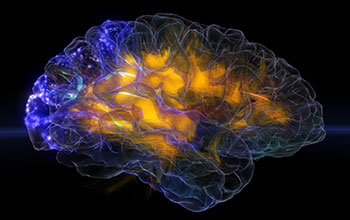Multimedia Gallery
"Glassbrain" (Image 1)
"Glassbrain," by Adam Gazzaley, Roger Anguera Singla, Rajat Jain, Tim Mullen, Christian Kothe, John Fesenko, Oleg Konings and Matt Omernick; University of California, San Francisco.
Part education tool, part neuroscience party trick, the Glassbrain app was first used on stage in 2012 on Mickey Hart, former drummer for the Grateful Dead, to show his brain reacting to music. A cap detects the different types of waves and signals pinging across the user's brain. The app then displays them in real time on a 3-D image built from brain scans taken earlier. Each color represents source power and connectivity in a different frequency bands -- theta, alpha, beta, gamma -- and the golden lines are white matter anatomical fiber tracts. Estimated information transfer between brain regions is visualized as pulses of light flowing along the fiber tracts connecting the regions.
Right now, the app is not sophisticated enough for clinical applications, but is mainly used for education and entertainment. But Roger Anguera Singla, one of the app's programmers at the University of California, San Francisco, hopes to build in value for medical professionals, too; for example, to allow neurosurgeons to "fly inside" a functional brain and better plan an upcoming surgery.
This screen capture (one of three in a series) won experts' choice (first place) in the games & apps category of the 2015 Visualization Challenge, now called The Vizzies, a long-running, annual competition co-sponsored by the National Science Foundation and Popular Science. [The competition was formerly named the International Science & Engineering Visualization Challenge (SciVis) and was previously co-sponsored with AAAS' journal Science.] The competition aims to recognize some of the most beautiful visualizations from the worlds of science and engineering and awards prizes in five categories: photography, video, illustration, posters & graphics and interactives.
To learn more about the competition and view all the winning entries past and present, see the NSF The VIZZIES: Visualization Challenge Special Report. (Date of Image: unknown) [Image 1 of 3 related images. See Image 2.]
Credit: Adam Gazzaley, Roger Anguera Singla, Rajat Jain, Tim Mullen, Christian Kothe, John Fesenko, Oleg Konings, and Matt Omernick
See other images like this on your iPhone or iPad download NSF Science Zone on the Apple App Store.
Images and other media in the National Science Foundation Multimedia Gallery are available for use in print and electronic material by NSF employees, members of the media, university staff, teachers and the general public. All media in the gallery are intended for personal, educational and nonprofit/non-commercial use only.
Images credited to the National Science Foundation, a federal agency, are in the public domain. The images were created by employees of the United States Government as part of their official duties or prepared by contractors as "works for hire" for NSF. You may freely use NSF-credited images and, at your discretion, credit NSF with a "Courtesy: National Science Foundation" notation.
Additional information about general usage can be found in Conditions.
Also Available:
Download the high-resolution JPG version of the image. (1.1 MB)
Use your mouse to right-click (Mac users may need to Ctrl-click) the link above and choose the option that will save the file or target to your computer.

